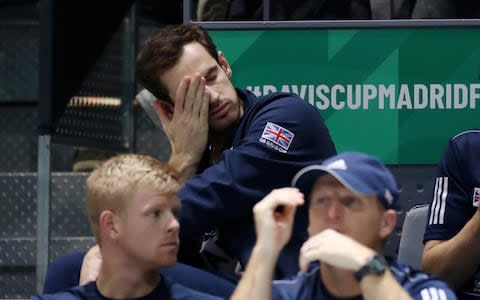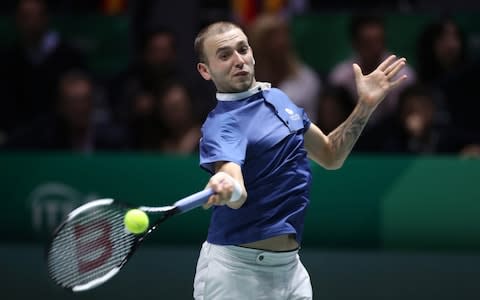Rafael Nadal almost single-handedly ends Great Britain's run at Davis Cup as Spain reach first final since 2012

The shout from the crowd was “Nadal presidente”, as the world No 1 almost single-handedly ended Great Britain’s magnificent run at the Caja Magica. But there was a cynical side to Spain’s Davis Cup victory, which opened with a last-minute switch of personnel that Dan Evans described as “a little bit naughty”.
Tennis-wise, Spain deserved their semi-final victory. Etiquette-wise, they let themselves down by needlessly bluffing over their choice of second singles player. Declaring their team an hour before the scheduled start, they picked Pablo Carreno Busta, a classic right-handed grinder from the clay-court tradition. But with just five minutes to go, they whipped Busta out and replaced him with left-handed serve-volleyer Feliciano Lopez.
Edmund called it “mind games” but he dealt with the situation brilliantly as he walloped Feliciano Lopez to claim the first point of the Davis Cup semi-final.
In the second rubber, Evans then suffered the straight-sets defeat that tends to befall anyone who goes up against Nadal in this competition. This left the whole shooting match to be decided by the doubles rubber – which pitted Nadal and Lopez against the specialist pairing of Jamie Murray and Neal Skupski.
The match was so tightly fought that there were no breaks of serve, only a pair of tie-breaks, which Nadal dominated with his muscular hitting and intense focus. In the end, Spain’s 7-6, 7-6 victory sent them through to Sunday's final.

Earlier, Spanish captain Sergi Bruguera had used a little-known rule from the Davis Cup handbook to change his No 2 singles player only a few minutes before the anthems. “I found out five minutes before,” said Edmund later, when asked about Spain’s chicanery. “Busta actually came to warm up. He was on the bike two minutes, then he left. I said straightaway, ‘Something is a bit weird there.’ Then straightaway the guy [Lopez] came in.
The rules say that you can make a change at the last minute if the doctor on site agrees that there is an injury involved. In this case, Spain cited a left-leg problem for Busta. The awkwardness here is that Busta had clearly been struggling at the end of his match in Friday’s quarter-final against Argentina, so every smart observer knew he was going to be touch-and-go. A rule designed for last-minute strains and sprains was being abused in the hope of creating uncertainty in the British team.
Lopez certainly presented a very different challenge. He is a left-handed serve-volleyer who plays a decidedly untypical game for a Spaniard. British tennis fans will remember the lethality of his serve and forehand from the doubles partnership that Lopez struck up with Andy Murray at Queen’s this summer, seeing off all opposition to lift the title in a thrilling boost to Murray’s comeback.

Lopez, amazingly, is 38 – just a few weeks younger than Roger Federer – and already has a sideline as the tournament director of the Madrid Masters, which is staged at this very venue in May. But after starting cold in his first game he was almost impossible to break. Edmund was able to dominate from the back of the court, using his huge forehand to boss Lopez around. But as soon as Lopez arrived at the net, he was almost flawless.
Edmund staved off some real pressure moments in the second set, notably a 15-40 service game that he escaped with another ace and some ferocious strikes from that bazooka of a forehand. One he had forced a tie-break, Lopez seemed to tighten up, sending down what was only his second double-fault of the match to surrender the initiative – and, a few minutes later, the match by a 6-3, 7-6 margin.
That left Great Britain just one point away from the Davis Cup final and a crack at Canada, who had earlier overcome Russia by the tightest of margins. But to win that point, they needed to get past the world’s best player.
Nadal came into the semi-final on a run of 29 consecutive wins in the Davis Cup, across both the singles and doubles format, which is the longest in the 119-year history of the competition. That soon became 30 after he outclassed British No 1 Evans in the singles. The early stages of this match were competitive, as Evans buzzed about the court like a mosquito. There were even a couple of signs that Nadal was feeling discomfited, notably when he wagged his index finger furiously at a line-judge who had made a bad call.

But as Evans served at 4-5 in the first set, Nadal entered a zone of focus that carried him through the rest of the match without losing another game. His forehand was at its ferocious best, and over the last year or so he has beefed up his serve – which was once a weakness – into a real weapon. The mosquito encountered Nadal’s rolled-up newspaper and that was the end of the contest.
Nadal was to produce heroics again in the doubles as Spain reached their first Davis Cup final since 2012 where they will face Canada, who also won a cliffhanger earlier in the day against Russia.

 Yahoo Sport
Yahoo Sport 





































